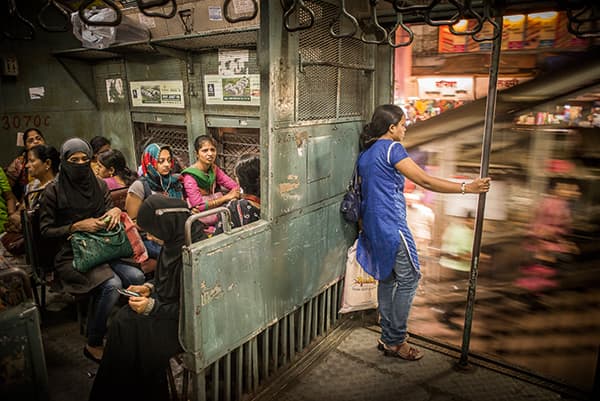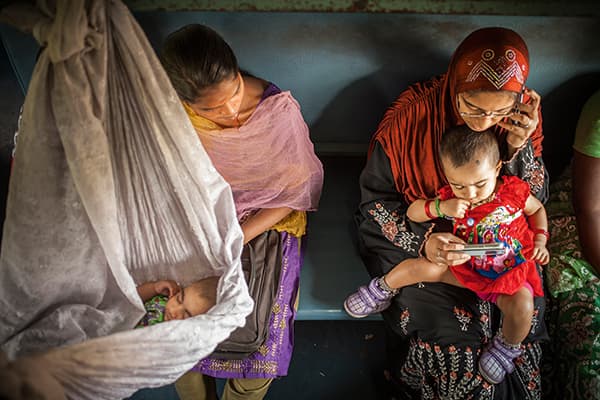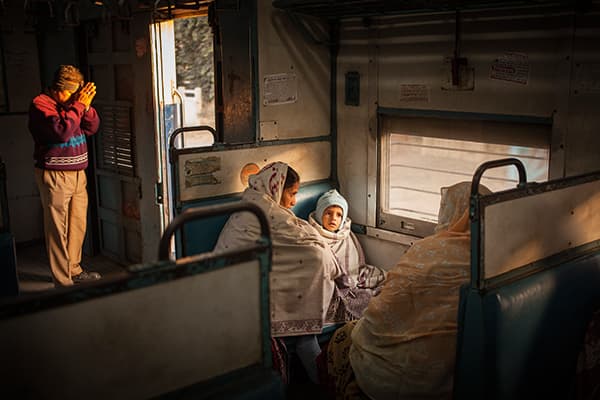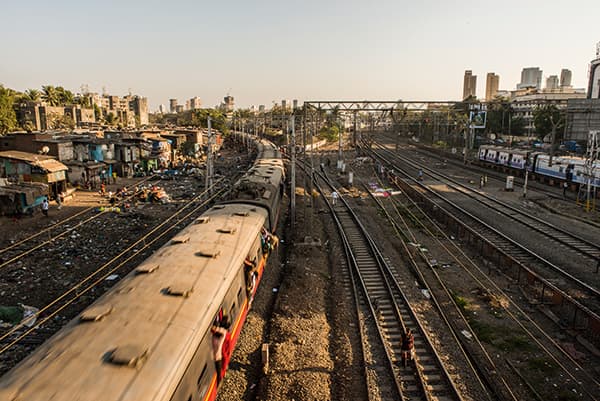
A woman looking into the Mumbai night. Beside her we see women from a variety of Indian cultures, all of whom sit in the ladies’ compartment of this local train
As a child, photojournalist Tamina-Florentine Zuch would spend days wandering around the farm she grew up on, filming everything while commentating and documenting what was happening. These days, she holds a camera rather than a video recorder, but her aim is much the same, albeit on a larger scale and with more exotic locations. ‘Although early on I was more interested in filming, my focus shifted to photography after I graduated from high school,’ says Tamina-Florentine.
‘Photojournalism and documentary photography are, for me, the keys to everything I want to do: travel, meet people, experience all the different worlds out there.’

Selling food on the suburban train in Kolkata
Tamina-Florentine has certainly embraced that aim wholeheartedly. At just 25 years old, she has a diverse portfolio that reaches far beyond her home country of Germany. And that early experience has paid off – this year she took home t15,000 worth of Zeiss lenses after winning the Zeiss Photography Award, an international photography contest launched in collaboration with the World Photography Organisation.
The project that won her the prestigious accolade takes in the frenetic world of the Indian railway network. Over a period of several weeks, Tamina-Florentine set out to document the chaos and commotion found within the vast Indian rail network.
She took the prize-winning photographs during an exchange programme at the National Institute of Design in India while she was completing her fourth year of study at the University of Hanover. Staying in Gandhinagar, the capital of Gujarat in western India, from November 2014 to March 2015, Tamina-Florentine wanted to immerse herself in the cultural aspects of a new country, and find a big photographic project to work on. She decided to combine the two and travel around India by train.
‘India has one of the largest and most widespread rail systems in the world,’ she explains. ‘Almost every corner of this massive country can be reached by train. As the distances are so far and the trains move so slowly, you can spend hours, sometimes days on one train journey. My idea was to get an insight into the life of the travellers.’

Swathes of men attempt to board an already crammed local train in Mumbai
Planning the journey
A potential issue Tamina-Florentine faced was attending her course at the University in Gandhinagar, so she could not just pack up and disappear for a few months. Instead, she meticulously planned a series of trips that brought her back to her home base each time. It was a more disjointed approach, but just as productive, she says.
‘Most train journeys took one to two days,’ she explains. ‘The longest I travelled without pausing was the train from Kolkata to Kanyakumari. I got on the train at 4am; I spent two nights on the train and arrived in Kanyakumari three days later at 11pm. It was really exhausting, though, especially because I had to share my bed with at least two other people and I was alert almost all the time to not miss a moment. I found the best length of travel time to get close to people and be able to concentrate full time were train journeys that took two days and one night.’

Young women with their children in the ladies’ compartment of a local train. The child sleeps in a makeshift hammock
Apart from local journeys between Ahmedabad and Gandhinagar, Tamina-Florentine’s project can be split into three sections, comprising three expeditions away from her home base. The first was a train north to Shimla.
‘This place was high up in the mountains, in the foothills of the Himalayas. From there I travelled through the valley of the Ganges river to Varanasi,’ she says.
The second trip was from Kolkata in the east to Kanyakumari, the southernmost point of India.
‘One could say that the Arabian Sea, Bay of Bengal and Indian Ocean meet here,’ says Tamina-Florentine. ‘After spending a day resting at this magical place, I headed back north, travelling along the west coast to Mumbai.’ The third trip took her to the interior of India, to Hyderabad and Hampi.

A woman herds goats through the desert landscape in India
Personal moments
Anyone who has viewed documentaries on India will be well aware of the claustrophobic environment of Indian trains, which are packed full of passengers, some of whom opt to travel on the roofs of carriages. Tamina-Florentine says having to operate in these confines – manoeuvring through tight spaces – was to the benefit rather than the detriment of her photos.
‘Spending so much time in such a confined space with almost no privacy meant it was possible [for me] to get really close to the people,’ she explains. The key to getting good photographs in this situation was to build relationships with fellow passengers, but being an outsider was also of use.
‘As soon as I entered a compartment, the people would stare at me anyway: I am tall, blonde and pale. Although I wore appropriate clothing and covered my hair, I was never able to blend in with the crowd. So they saw me and then they saw my camera. Most of the time I started talking with the passengers first and took my seat. As soon as the atmosphere settled, I started photographing. Either people would tell me that it was fine with them if I took their photo, or I would look at them holding up my camera and wait until they would nod or smile. I hardly had any problems with people not wanting to be photographed.’

A young man leans out of a moving train while his friend takes a picture
Tamina-Florentine did not always ask first, though: sometimes a moment demanded retrospective permission. ‘I carried my camera openly with me all the time,’ she says. ‘Most of the time I used a Nikon D800 with a 35mm lens.
If I ran into a situation that seemed perfect, I wouldn’t ask for permission first as that would have destroyed the moment. But I would tell them later that I took a picture. I guess all photographers have to find their own way of dealing with that. It depends on the topic, too. But for me and this particular story – being in a foreign country, capturing moments of privacy – it was important that the people didn’t feel offended.’
That desire to get the true personal moment, unaffected by the lens of the camera, determined how Tamina-Florentine composed and lit her pictures.
‘I never used flash,’ she reveals. ‘I used what available light there was, be it sunlight or the light coming from the electric lights on board the trains. For me, it is all about light, atmosphere and composition.’
Tamina-Florentine stipulates that good lighting was an incredibly important factor when it came to composing her images. ‘The best light was to be found early in the mornings and shortly before sunset, when the sunlight would flood through the window and fill the compartments with this beautiful dusty light,’ she says.

A young man gazes out at the warm light of sunset
Composing the shots
When it came to composing her images, Tamina-Florentine would focus on a situation that would reflect a particular mood or feeling. Often she would look for multiple situations occurring within a single frame to emphasise these emotive moments. ‘I would try to unite more than one of these situations in one shot,’ she says. ‘For example, the photograph I took of a man praying in the morning sun, while a family sat together cuddled up in blankets against the morning cold, conveys this well.’

Two women and a child wrapped up against the morning cold, while behind them a man offers a prayer to the sun
Many of her images have the spontaneity that suggest an easy job for the photographer – that the trains are full of life that she just had to sit back and record it. However, this was not the case at all. ‘Sometimes I had to wait hours or even days for one picture,’ reveals Tamina-Florentine.
‘[It was] also important for me not to have too much presence in the picture as a photographer. I stuck to the people for a long time until they got used to me and my camera. After a while, they ignored me and that was the time when I could start to work.’
This determination and patience to get the right shot will be key in Tamina-Florentine’s next project. She has decided to cover the huge – and currently very relevant – topic of migrant workers. But rather than the workers themselves she will focus on the families they have left behind and the situations that have led these workers to leave their home country.
It will require extensive travel and be incredibly demanding personally, but having already travelled 20,000km [12,427 miles] along the railways of India, she is no doubt ready to undertake such a challenge.

An evening shot of a local train in Mumbai
About Tamina-Florentine Zuch
Tamina-Florentine Zuch currently lives in Hanover, Germany, and is studying photojournalism and documentary photography. You can see more of her work at www.tamina-florentine.com








